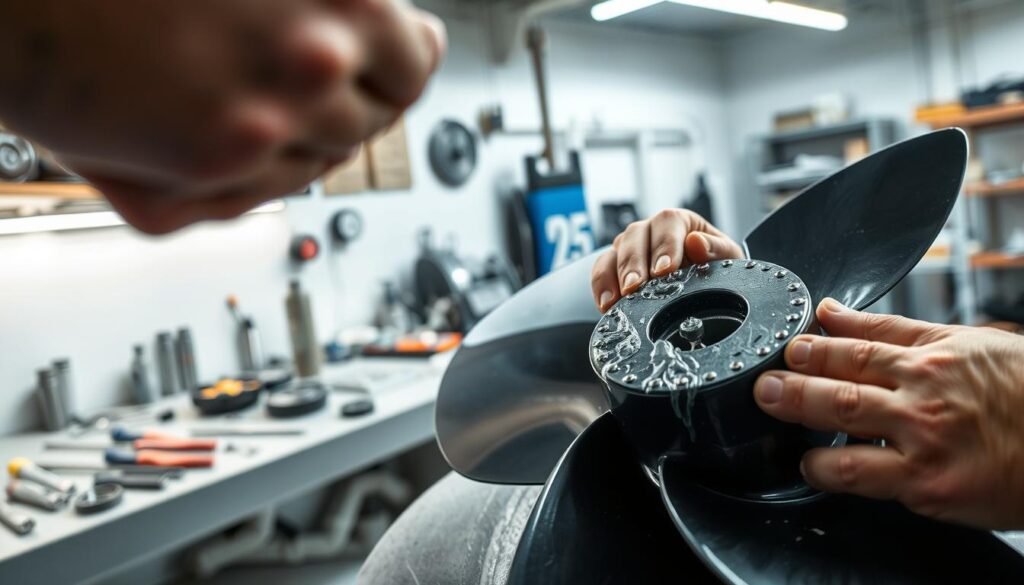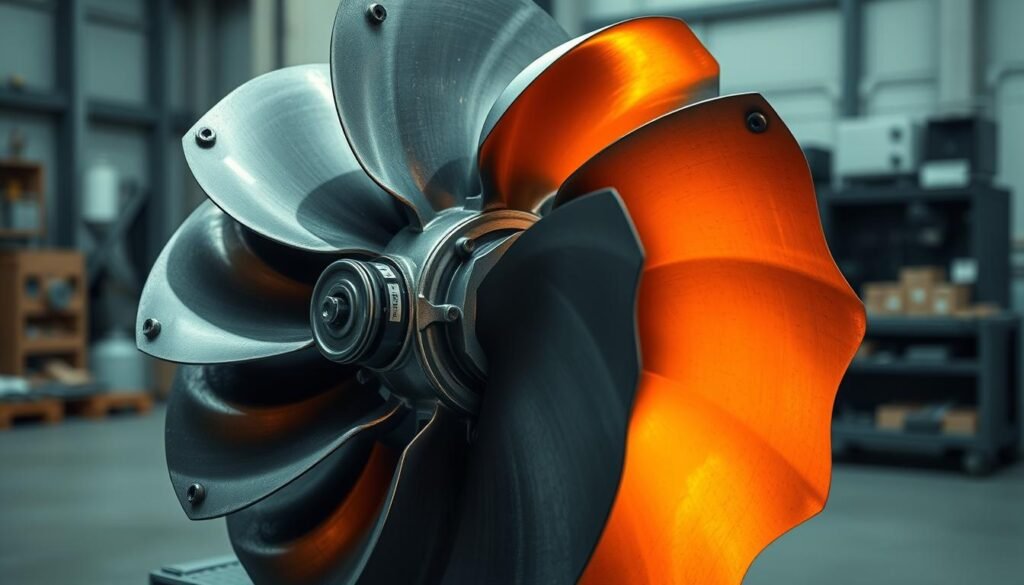An impeller is key in many industries, and too much noise is a big problem. If ignored, it can lower efficiency, raise energy use, and pose safety risks. It’s important to find ways to reduce impeller noise to keep things running smoothly and avoid downtime.
Knowing how to tackle impeller noise is a must for maintenance. By studying the noise, technicians can figure out the best way to cut down on it. The aim is to reduce noise without losing performance, which can be done with good maintenance, repairs, and replacing old parts.
Too much noise from an impeller can come from imbalance, misalignment, or worn-out parts. Finding out why it’s noisy is the first step to fixing it. By understanding different types of impeller noise, technicians can find effective ways to make it quieter. This not only cuts down on energy use but also boosts efficiency and system performance.
Understanding Impeller Noise Characteristics
Impeller noise is a big problem in many industries. Knowing what causes it is key to fixing it. Impeller noise causes can vary, from mechanical problems to how things are run. So, it’s important to do a detailed impeller noise diagnosis.
It’s important to know the different kinds of noise. These include:
- Vibration noise, often caused by imbalance or misalignment
- Cavitation noise, resulting from the formation and collapse of vapor bubbles
- Turbulence noise, generated by fluid flow and turbulence
Knowing the difference between normal and abnormal noise is critical. Impeller noise diagnosis helps figure out what’s causing the noise. Things like flow rate, pressure, and temperature play a big role in noise levels.
Understanding these factors helps spot and fix impeller noise causes. This knowledge is essential for doing a good impeller noise diagnosis. It helps find the right solutions to reduce noise and improve performance.
| Noise Type | Description | Possible Causes |
|---|---|---|
| Vibration Noise | Low-frequency noise caused by vibration | Imbalance, misalignment, worn bearings |
| Cavitation Noise | High-frequency noise caused by cavitation | Low pressure, high flow rates, inadequate suction |
| Turbulence Noise | Medium-frequency noise caused by turbulence | High flow rates, inadequate piping, poor design |
Primary Causes of Excessive Impeller Noise
Excessive impeller noise can come from many sources. These include design problems, wrong installation, and neglect in maintenance. To tackle these, it’s key to do detailed impeller noise troubleshooting and use good impeller maintenance methods.
Some common reasons for too much impeller noise are:
- Imbalanced impellers, which cause vibrations and noise
- Worn or damaged impeller blades, leading to noise and less efficiency
- Choosing the wrong impeller size or type, causing noise and poor performance
To stop too much impeller noise, regular impeller maintenance is vital. This includes checking, cleaning, and balancing. Spotting and fixing problems early helps avoid noise and keeps the impeller working well.
Good impeller noise troubleshooting mixes visual checks, vibration analysis, and performance tests. These methods help find the noise’s source fast and fix it right.

By focusing on impeller maintenance and impeller noise troubleshooting, you keep your impeller reliable and efficient. This also cuts down on noise and other problems.
Diagnostic Steps for Troubleshooting Noisy Impellers
To fix noisy impellers, a systematic approach is key. Understanding impeller noise reduction strategies and using impeller troubleshooting methods is essential.
Start with a visual check to spot wear or damage. Then, use vibration analysis to get deeper insights into the impeller’s condition.
Visual Inspection Techniques
Visual checks are a first step in finding noisy impellers. Look for wear, misalignment, or other issues that might cause the noise.
Vibration Analysis Methods
Vibration analysis is a more detailed method. It can find problems like imbalance or misalignment that aren’t seen in a visual check.
Performance Testing Procedures
Performance testing is the last step. It checks how well the impeller works and finds ways to improve. By using impeller noise reduction strategies and doing thorough impeller troubleshooting, you can lower noise and boost performance.
| Diagnostic Step | Purpose |
|---|---|
| Visual Inspection | Identify visible signs of wear or damage |
| Vibration Analysis | Detect imbalance, misalignment, or other operational issues |
| Performance Testing | Assess operational efficiency and identify areas for improvement |
Effective Impeller Noise Reduction Strategies
Reducing impeller noise is key for efficient and quiet operation in many industries. One main strategy is to improve the impeller design. This can be done by changing the shape, size, or material to cut down on vibration and noise.
Some effective ways to reduce impeller noise include:
- Implementing design modifications, such as changing the impeller’s blade angle or adding noise-reducing features
- Upgrading materials to those with better acoustic properties, such as using sound-absorbing materials
- Adjusting operational parameters, such as speed or flow rate, to minimize noise generation
By using these strategies, industries can greatly reduce impeller noise reduction and boost efficiency. For instance, a study showed that better impeller design can cut down noise levels a lot. This makes the work environment more comfortable and safe.
It’s important to remember that the best way to impeller noise reduction is often a mix of these strategies. They need to be tailored to the specific needs of each application and situation. By understanding the causes of impeller noise and applying targeted solutions, industries can see big improvements in noise levels and performance.
Maintenance Practices to Prevent Noise Issues
Regular maintenance is key to avoiding noise problems with impellers. A routine inspection schedule, proper cleaning, and checks for alignment and balance are essential. These steps help spot and fix issues early, reducing the need for troubleshooting and downtime.
Creating a regular inspection schedule is vital for your impeller’s health. It should include daily, weekly, and monthly checks. Look for wear, misalignment, and imbalance during these inspections.
Regular Inspection Schedule
- Daily checks: Monitor the impeller’s performance and look for signs of unusual noise or vibration.
- Weekly checks: Inspect the impeller for signs of wear and tear, and check the alignment and balance.
- Monthly checks: Perform a thorough inspection of the impeller and its components, and make any necessary adjustments or repairs.
Proper cleaning is also critical to avoid noise problems with impellers. Cleaning regularly removes dirt and debris that can cause vibration or noise. By adding impeller maintenance to your cleaning routine, you can prevent these issues and cut down on troubleshooting needs.
Proper Cleaning Procedures
Alignment and balance checks are also vital to prevent noise issues with impellers. Misalignment or imbalance can lead to vibration and noise, causing wear and tear. Regular checks ensure your impeller works well and reduces troubleshooting needs.
| Inspection | Frequency | Procedure |
|---|---|---|
| Daily | Daily | Monitor performance and look for signs of unusual noise or vibration |
| Weekly | Weekly | Inspect for signs of wear and tear, and check alignment and balance |
| Monthly | Monthly | Perform thorough inspection and make any necessary adjustments or repairs |
When to Seek Professional Assistance
Dealing with impeller noise can be tough. Sometimes, you need a pro’s help. If you’ve tried many ways to reduce noise and it doesn’t work, it’s time to call an expert. They can find the problem and fix it, like repairing or replacing the impeller.
Warning Signs of Serious Problems
There are warning signs you need help. These include:
- Excessive vibration or noise that exceeds normal levels
- Decreased performance or efficiency
- Increased energy consumption
If you see these signs, get professional help fast. This prevents more damage and keeps your equipment working well.

Choosing a Qualified Service Provider
When picking a service provider, look for experience and expertise. A good company can create a plan to reduce noise and keep your equipment running well.
Conclusion: Ensuring Long-term Quiet Operation
Keeping your industrial equipment in good shape is vital for quiet operation. Regular checks on impellers and quick maintenance are key. They help spot and fix noise problems early on.
By using the noise reduction tips from this article, you can keep your impellers working well. This keeps your operations quiet and efficient.
Fixing impeller noise is more than just reducing noise. It also helps your equipment last longer and work better. Stay alert, follow the best practices, and get help when needed. With the right steps, your industrial operations will stay quiet for many years.
